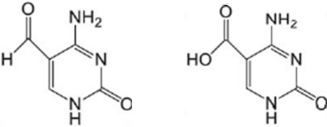Researchers identify seventh and eighth bases of DNA
July 25, 2011

New 5fC and 5caC bases (credit: Shinsuke Ito et al.)
Researchers from the University of North Carolina (UNC) School of Medicine have identified the seventh and eighth bases of DNA.
For decades, scientists have known that DNA consists of four basic units — adenine, guanine, thymine, and cytosine. In recent history, scientists have expanded that list from four to six.
Much is known about the “fifth base,” 5-methylcytosine, which arises when a chemical tag or methyl group is tacked onto a cytosine. This methylation is associated with gene silencing, since it causes the DNA’s double helix to fold even tighter upon itself. Last year, the researchers found that Tet proteins can convert 5 methylC (the fifth base) to 5 hydroxymethylC (the sixth base) in the first of a four-step reaction leading back to cytosine.
However, the researchers could not continue the reaction on to the seventh and eighth bases, called 5 formylC and 5 carboxyC. The problem was that their experimental assay wasn’t sensitive enough. They redesigned it and were able to detect the seventh and eighth bases — called 5-formylcytosine (5fC) and 5 carboxylcytosine (5caC) — which are actually versions of cytosine that have been modified by Tet proteins, molecular entities thought to play a role in DNA demethylation and stem cell reprogramming.
The researchers then examined embryonic stem cells as well as mouse organs and found that both bases can be detected in genomic DNA.
Their findings could have important implications for stem cell research, since it could provide researchers with new tools to erase previous methylation patterns to reprogram adult cells. It could also inform cancer research by giving scientists the opportunity to reactivate tumor suppressor genes that had been silenced by DNA methylation.
Ref.: Shinsuke Ito, et al., Tet Proteins Can Convert 5-Methylcytosine to 5-Formylcytosine and 5-Carboxylcytosine, Science, 2011; [DOI: 10.1126/science.1210597]